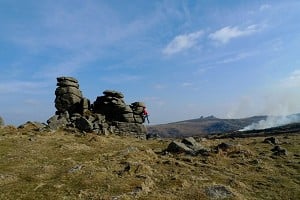
Dartmoor, home to the roughest rock in the country, has long been something of a bouldering backwater. Lacking the proximity to such large population centres as its northern counterparts (namely the Peak District and Yorkshire), development has been slower and carried out by much smaller numbers of climbers. The recording of all of this has not always been very comprehensive but in this article I will attempt to give a general overview of how bouldering here has progressed over the years…
Pre 95
The main crags of the moor had 'always' been bouldered on by locals (notably Chris Nicholson, Pete Bull, Nick White, Martin Perry + various Totnesians, Steve Thorpe, Simon Cook, Paul Twomey, Bjorn Aïkman, Ken Palmer, Andy Grieve, Nick Hancock, Pete O'Sullivan, Pete Saunders, Mark Reeves, Pat Littlejohn, myself and countless others) although prior to 1995 very little of this was recorded and much of the history is unknown. Even Bonehill's The Wave, one of the most impressive and coveted problems on the moor, is of uncertain provenance - was it Chris Nicholson in the late 80s? I remember the first climbers I saw trying it were a gaggle of reprobates from the Totnes area (with assistance from a 'cheat stone' to avoid the first, crux move) - this was in the mid 90s, around the time I climbed it myself.

Notable exceptions to this deficit of documentation were made at Saddle Tor where the highball problems (before the term was coined) were so substantial they were recorded as routes - Björn Again f6A and Mezzontinter f5 being the main examples, given E2 and E1 respectively.
It's also worth mentioning that the trend of naming bona fide boulder problems (as opposed to mini-routes like those at Saddle Tor) probably began in the early 90s at Hound Tor when Paul Twomey started with the likes of Wish f6C and Skin Graft f5+ (or Plymouth 5c as it was given at the time!).
1995 - 2000
1995 saw the arrival of Nick White's South Devon and Dartmoor guidebook. Whilst this focused primarily on route climbing in the region, it also contained artistic topos of a handful of crags on the moor and its aureole. The obvious venues of Bonehill and Combeshead were detailed along with off the beaten track spots like the Sacrificial Virgin Boulder at Lustleigh, Manaton Rocks (now banned but home to the excellent Yew Geste f6B) and Ausewell Rocks. This illustrated that very capable climbers had been exploring the Shire's potential before the explosion of bouldering in the mid to late 90s.
The period following this seminal publication was largely dictated by some lazy locals not wanting to stray too far from the 'Hound of the Basket Meals' burger van at Hound Tor. Attention was mostly focused on the obvious remaining lines of the open moor tors, such as Saddle Tor's Dancing Queen f7B (1994/5) and Bonehill's Lowla f7B (1997), The Wave Traverse f7C+, Tsunami f7C+, Ivory Mountain f7C and the moor f7C which all went on to become classic test pieces. Saddle Tor also saw the addition of Super Trouper f7C (1999); prior to the first ascent, this was tried during a Red Chili climbing shoe demo day (after first hydrating in the Rugglestone Inn) with brand rep Richie Patterson plus locals Simon Young, Dave Ferguson and myself. Although we all made some progress, nobody was successful but luckily, I was able to go up the following day. The tor was shrouded by low cloud and a little drizzle blew in from the west - suboptimal. I thought it worth a walk up to the crag anyway and, finding the rock completely sheltered and dry, managed to bag the first ascent.
Lustleigh Cleave saw attention during this period, largely by Ben Rowe et al., Martin Crocker, Craig Williams, Anthony Snow, Jason Maddick, myself and probably others. As was the norm, it was assumed that lower grade problems had been climbed previously and naming and claiming everything was not really the done thing. A handful of lines up to f6Cish were climbed mostly around Nutcrackers and Harton Chest. I have clear memories of wandering in the Cleave in the rain looking for and occasionally finding impressive boulders.
1999 also saw a write up of the bouldering at Bell Tor (a chalk bag's throw from Bonehill). This venue had without doubt seen traffic before although several of the problems climbed at the time were new, most notably Famous Grouse f7A.
2000 - 2003
The new millennium started in much the same vein as the end of the last with new discoveries trickling in at a leisurely pace. At some point during the summer of 2000, I stumbled (probably in a burger fuelled haze!) across The Cream Traverse f7A+ at Hound Tor whilst Ben Rowe and his gang discovered Black Hill Boulders. Here, they added a good circuit of low and mid grade problems with the usual caveat that some had probably been climbed before.
The winter of 2000 was especially wet and the spring of 2001 saw the arrival of restrictions to crag access due to the foot and mouth outbreak. With the exception of some beach bouldering (such as Northcott on Cornwall's north coast), climbing outdoors ground to a halt. This did, however, catalyse the birth of javu.co.uk which provided guides to the bouldering on Dartmoor. This basic website sparked a re-examination of many moorland crags, resulting in numerous problems being recorded at the moor's unexploited crags.
With the lifting of access restrictions, I went back to climbing on the user-friendly moorland crags with additions like Easdon Arete f7A+ (2001), Abba Gold f8A (2001) and Hidden Low There and Back (2002) at Saddle Tor (a long link up which set a bad example for future generations) plus Alan Smith f7C (2002) at Hound Tor. The latter problem was named after the then gentleman proprietor of the aforementioned burger van; this fine establishment sadly no longer exists but many a visitor has fond memories of the excellent locally sourced burgers and range of teas ("er boys, would you like Earl Grey, Lady Grey, Lapsang Souchong or Truckers' tea?").
Around this time Dartmoor gained a devotee in the name of Tom Rainbow. Tom, already an accomplished climber, hadn't previously got the bouldering bug but prospecting seemed to inspire him. Initially with chaps like Jason Maddick (himself a seasoned Dartmoor bouldering aficionado) and Jon Wilson, they added and documented problems at Tunhill Rocks, Smallacombe and Honeybag Tor and this period marked a change in the diligence with which bouldering on the moor was recorded.

Dan Arkle carried out a similar operation at Combeshead Tor on the janner side of the moor. This crag was well established (having long been climbed on by Plymouthians such as Ken Palmer, Andy Grieve, Pete Saunders, Rick Meek and Nick Hancock) and already home to many classics. However, Dan and others did an excellent job of venturing off the usual circuit to discover and write up a host of mostly lower to mid grade problems. Dan produced a topo to the crag which then formed the basis for one on javu.
Around the same time, a team of outsiders 'not from round these parts', spearheaded by the Bristol-based Luc Percival and Ian Hill, discovered some of the delights of Dartmoor for themselves and recorded their explorations in the climbing magazines. Working on the assumption that Dartmoor locals hadn't bouldered at these venues, some confusion - and sadly ill-feeling - ensued as first ascents were claimed when in reality much of what was thought to be 'new' had been climbed before (in some cases long before) but left unrecorded.
Lustleigh Cleave didn't escape the gaze of these visiting Bristolians which spurred on the climbing of bona fide new problems by both the 'foreigners' and locals alike. Ben Rowe and his crew probably spent the most time here and continued to explore the depths of the Cleave. Many excellent problems were climbed during this period although not all were written up; classics such as Harton Chestwig f6B and Stu's Moist Crack f6A stood out. Caedmon Mullin was also active, his best addition being Creamtime f7A+ (2003), and I climbed quite a lot here too, discovering most significantly Hung Like a Chimp f7A (2001), T.B.L f7B+ and Over the Hill f7A.
Other activity of note came from Craig Williams and his gang (occasionally including me) who paid regular visits to Hound Tor's lesser known neighbour, Hayne Down, starting in about 2003. This crag, as with most on the moor, had been climbed on sporadically in the past but never given sustained attention. Amongst various good problems, the highlights were Mint Sauce f6A-C (grade depending on the sequence) and problems at what latterly became known as Reece's Roof. These were not recorded at the time and the area was rediscovered in around 2013 by Reece Wotton, Gordon Snell and Andy Haley who documented their additions. Needless to say, this has made attributing who did what a challenge and the actual history has probably now been forgotten. Forgotten Wall f6C, for instance, had without doubt been climbed by the late 90s but didn't get written up until about 20 years later.
Craig was also active at Smallacombe during this period, usually with 'Irish' Phil Bowker. Some of their problems even got recorded - Orphan f6B and Yorkshire Tea f6C+ - largely thanks to Jason Maddick putting together a topo which was used as the basis for a guide on javu.
During the same period, I found a few more treasures on the moorland crags with highlights being Schmogon f7B at Holwell Tor (2003) (a sit start to the highball Dogon f6B climbed by Simon Young in 1998) and Stray Dog (Gone Defective) f7C+ (2004) at Hound Tor.
The Bovey Woods Era onwards
I can't remember exactly when, but rumours began circulating that Tom Rainbow had struck gold. It transpired that whilst out walking his dog, Tom had stumbled across a treasure trove of bouldering hidden away in the woods to the north of Bovey Tracey. Despite my own brief wander through the area with Mark Reeves (a keen local boulderer with a penchant for exploration) back in the mid 90s I managed to miss its significance, happening only upon a few mossy bits of rock.

In an attempt to throw me off the scent, Tom took me to a minor discovery of his, Bottor Rock (better known for its Wilja potatoes). Yet Tom's ploy didn't work - I found boulders around Stonelands of my own accord and was then introduced to more by the insiders. The ensuing years saw rapid development by Tom, Jason Maddick, Jez Holding, Jon Wilson and Simon Mooney. Tom was the most prolific and added 100s of excellent problems, but Simon Mooney demonstrated his eye for quality adding numerous lines including the classics Swansong f6C and Shimmer f6A. I clearly remember wandering around the bluebell carpeted woods during the cold, dry spring of 2004 climbing new problems - Slotted Wall f7A+, William Shaptor f7B+, The BBB f6B, Green Dot Traverse f7B, Undercover f6C, Underdog fFA+, Devon Sent f7C+, Dog's Dick Arete f6B were all climbed during this purple patch.
Other woodland areas were soon developed, the most significant being the excellent Cartoonlands, predominantly by Jason Maddick and James Clapham. Gidleigh Woods, a smaller but intriguing spot on the northern fringes of the moor, was discovered and developed by then Chagford resident Caedmon Mullin.
2006-8 saw a resurgence of activity at the established moorland crags. The now famous James Pearson made a flying visit to Honeybag Tor to produce, err, Flying Visit f7C. At Hound Tor I scratched my way across the Shark's Fin boulder to produce Mako f8A (2007) and Caedmon added Tuppy f7C (2008), the latter being a remarkably overlooked line on an established boulder (which he named after his dog!); Bonehill saw the addition of Floater f7C, a prominent higher traverse line on the Wave which I'd been putting off for years thanks to it's ugly landing. Not long after, I once again set a bad example to the kids (who have now made an art of claiming link ups on the Wave) by climbing the big link up of The Green Room f8A+, a hybrid taking in sections of most of the existing problems.
The Bovey Woods area continued to see developments largely spearheaded by Tom Rainbow. Others made significant additions, most notably Jason Maddick eventual success on Calcaneum Crisis f7A+ (2007). This had been a project for a while, a fall from which broke Jason's ankle. Then Jon Wilson added the much coveted classic of Nether Edge f7A+ (2007) plus the lesser-known Airstream f7A+. All of this was well recorded thanks to the herculean efforts of Tom, initially on his Shaptor wiki website and then latterly on UKClimbing.com. His tireless enthusiasm has been a driving force behind development of the the moor's fringes.
Sometime around 2009, Caedmon Mullin added the excellent, high and obvious Salad Fingers f7A to Hayne Down.
Rumblings of activity started to emanate from the west of the moor in 2010. The Barn - a climbing wall opened in a barn (who'd of thunk it!) near Launceston by pioneering local climber Simon Young - spawned the progression of a batch of climbers, most notably Mikey Cleverdon and Tom Bunn. Tom first came to prominence with his Rusty Peg website, for which he produced a guide to the bouldering at Burrator. Discovered by at least one person in the past (the aforementioned and omnipresent Mark Reeves), Tom's documenting of the crag provided a worthwhile addition to the bouldering options on this side of the moor. Home to a good range of problems, it gained popularity in 2010 partly thanks firstly to King of the Swingers f7B+ and then it's progeny Jungle V.I.P. f7C+, both by upcoming Mikey Cleverdon. The latter was initially given f8A which, combined with its modern-style-roof-swinging-eliminate-near-the-ground nature, made it a rapid success. Mikey also added Peeping Tom f7C (2010) to Combeshead Tor - these additions suggesting what he might move on to…

Also of note, 2010 was the year I took up road cycling to get a bit fitter and lighter (I'd become a bit chubby over the preceding years, due to a penchant for burgers, pasties and curry). Though I did become a bit fitter and lighter, the dark side took hold of me and I started to climb less, still getting out on the moor but not with quite the same drive as before.
In 2011, Murray Dale (a very talented dark horse well known for squeezing juice out rock) succeeded on the incredible highball The Junglebook f7B+ in the depths of Bovey Woods.
Over time, Dartmoor bouldering continued to become of more appeal to the masses, a good example being Down Tor on the Plymouth side of the moor. Whilst the crag had been pottered on for decades by those on their way to and from Combeshead Tor, only a few harder lines were claimed, namely Pagan Poetry f7A (2008) and Great Overhanging Boulder f7A+ (2009) by Joe Doyle and Mikey's Dyno f7A (2008) by, you guessed it, Mikey Cleverdon. This changed in 2013 when Andy Pemberton wrote up a few problems at Snappers Tor. Inspired by this, Pete Saunders started exploring and, surprised at the quantity of good easier problems and altruistically wishing to share them, meticulously documented all of the bouldering on offer.
In 2014 the hard climbing on the open moorland crags experienced something of a resurgence with the arrival of fresh eyes and ability. Marauding northerner Mike Adams got things moving with Oscillations f7B and Something and Nothing f7A+ on the left side of the Wave. James Squire, a name that went on to become synonymous with hard Dartmoor bouldering, started his campaign here with Catching the Wave f8A - the first line to breach the steepest part of the feature and one which opened the floodgates for the next round of development.
Mike Adams also put locals to shame at Smallacombe by adding Street Child f7C and Stray Waif 7B+, blatantly obvious lines right of Orphan. At Combeshead Tor he bagged the stunning Side Effects f7C+, once again a known-about line that locals had foolishly not applied their abilities to (although perhaps few possessed the requisite combination of imagination, wingspan and ability).
The Wave then bore witness to the moor's longest siege with Mikey Cleverdon's Pe'ahi f8A+ (2015) being the outcome - an inspiring display of his strength, commitment and supply of bouldering mats. This was arguably the last of the proper lines on the Wave. Multiple link-ups and extensions followed suit, more often than not by James Squire. Upcoming janner prodigy Alex Waterhouse and even I managed to incorporate the low start afforded by Pe'ahi into Tsunami and The Wave Traverse respectively, both at around f8A.
Alex impressed elsewhere with the additions of Aurora f7B (2015) and Hypothesis f7C (2015), two very obvious quality lines at Combeshead Tor.
Sexy Jesus
It was around this time that visiting American Walker 'Sexy Jesus' Kearney arrived on the scene. Unfortunately for locals who still had projects in the shire, Walker proceeded to discover (I think he had a man on the inside) and climb remaining lines throughout the area. Over roughly a 4 year period, he ticked off multiple 'last great problems' around the moor. Examples include Over the Mountain f7C+ (2015), Lazy Colon (2015) f7C, Yankee Doodle Dandee (2015) f7C, Great White Sloper (2016) f7C+, The Knavel f7C+ (2017), Walker's Last Sit f7C+/8A (2018) and Over the Rainbow f8A (2017). Walker was also active in the nethers of the moor at the virtually unknown Red Dragon Ridge where he climbed the outstanding Tropic Thunder f7C+. All in all, Walker's crop of new problems is hugely impressive and well and truly consolidated the standard of bouldering on Dartmoor. Geddon, as we say!
(For those interested, here's a link to Walker's favourite problems on the moor)
The iridescent Rainbow continued to sate his ravenous hunger for new rock with numerous discoveries: the limited Becka Brook, Wray Cleave, Wray Barton, Orgasmatron, Red Dragon Ridge and the Goldilocks Zone all being developed around this time. Climbing at the latter venue sadly, was subsequently banned when the landowner began noticing evidence of boulderers' activities - a real shame as the crag was, reputedly, excellent. Tom, along with various others, also revisited and reinvigorated Cartoonlands with the addition of many new problems to its excellent rock.
Around the same time, development continued at existing areas, in particular Lustleigh Cleave which saw a new wave of attention by different teams. Team Mark MacManus, Steve Pack, Lee Hogarth and Jason Maddick opened up a handful of problems in the Sharpitor area - The Candlestick Maker f6C, The Cowboy Butcher 2015, Back Door Butcher f6A, Kneel Before Zod f7A+ and Straight Up Steve f7A were all very worthwhile additions to a compact sector (1 or 2 may have been climbed before but not all). At this time, Steve Pack spotted the blatant slopey lip traverse which went on to become Super Sideways Steve f7C, probably his best and hardest addition to the moor. The other team active in the area was Andy Haley, Reece Wotton, Gordon Snell et al. Whilst some of the lines they recorded had been climbed before, they did add some great new problems including Clockwork Orange f6B+, one of the best on the moor. Mark MacManus went on to add the audacious neighbour Paths of Glory f6B. The Cleave continued to be relatively busy around this period with visits from numerous climbers including Walker and Tom Bunn who put his long arms to use to create Hot Crossed Bunn f7A+ (2017) - the solution to the impressive hanging arete at Harton Chest which had previously been climbed with a jump from a rucksack back in the late 90s.
In 2018, the obvious gap between the classic Bearacleave problems of Devon Sent and Nether Edge was filled with Abbeydale Road f7B+ by the fingers of the super strong and tenacious Alexis Perry. Alexis had previously bouldered extensively on the moor but not really become a devotee as he had interests elsewhere, namely the hard sport and trad climbing around the region. This went on to change…
After his Dartmoor debut at Bonehill in 2014, the name James Squire started to crop up more and more. For the highly accomplished Bristol based boulderer, Dartmoor became a regular haunt and James went on to climb many of the area's 'last great' lines. 2019 saw him climb the jaw droppingly impressive arete Interstellar f7C+ in the Bovey Woods. I'd looked at this myself on several occasions but never actually tried it; Walker Kearney had also given it some attention but didn't get around to finishing it off. James also ticked off some big lines on the Devon Sent boulder, Infamous f8A (2019) and Rocket Science f8B (2019). At Rock Copse, he succeeded on a direct line through the big roof to produce, err, The Big Roof f8B (2022).
James dragged Smallacombe Rocks near to the cutting edge of Dartmoor bouldering with his addition of Commitment Issues f8A (2022). This brilliant line had been a project of mine back in the 60s although I was put off by the height, reachiness and difficulty. More recently, the relatively low key but talented Ed Gow-Smith had applied a willingness to carry up large numbers of bouldering mats and was very nearly successful, falling off quite high on the line. At Holwell, James added the beautiful Right to Roam f8A, one of the best hard problems on the moor, and at Becka Brook he did battle with a stunning overhanging bulging arete to produce The Longest Goodbye f8B+…this is arguably unfinished business as James has also been trying a sit start.
Mikey Cleverdon continued adding new problems around the moor, of particular note being the logical and excellent link up of Tuppy f7C into Stray Dog f7C+ at Hound Tor. The resulting Stray Puppy f8A, despite not having any new climbing, makes the best use of the moves on this block to provide something better than the existing components. Mikey, a man of many projects, also added Bafa Roof f7C to Rock Copse not long after.
Seth MacDonald visited Bench Tor in 2021 where he added Stegosaurus f7C+ and X Marks the Choss f7B+; these 2 lines make excellent use of a great feature that had previously been avoided thanks to its iffy landing. Alexis Perry took a shine to these two and, after repeating them both, went on to add the longest, hard traverse on the moor The Hunger Games f8A (2023). Marred slightly by its proximity to the ground in its middle ("the ground gets a bit close...if you have any suspicion that a foothold is actually the floor, then it's probably forbidden"), this is a highly impressive line and well worth seeking out for aficionados of such exploits. Alexis also added Dartmoor's hardest crack problem with The Ten Commandments f7C (2022) to Cartoonlands.
Well, what of the future? In 2002 I wrote an article on javu suggesting that "Dartmoor will yield a few bits and pieces - some totally new classics and a few linkup type things. There may also be some interesting developments in wooded sections of the moor" and I'll make the same prediction now - except there'll be less of it and it'll be harder!
If you enjoyed this article, grab yourself a cream tea (cream first, then jam - we're not heathens) and crack on the classic South West bouldering film - Gone West.
- DESTINATION GUIDE: Dartmoor Bouldering - Gems in a Granite Setting 30 Jan, 2024
- REVIEW: Dorset Bouldering Rockfax 22 Jul, 2015
- The Climbers' Club Portland Guidebook 30 Sep, 2008
Guidebook
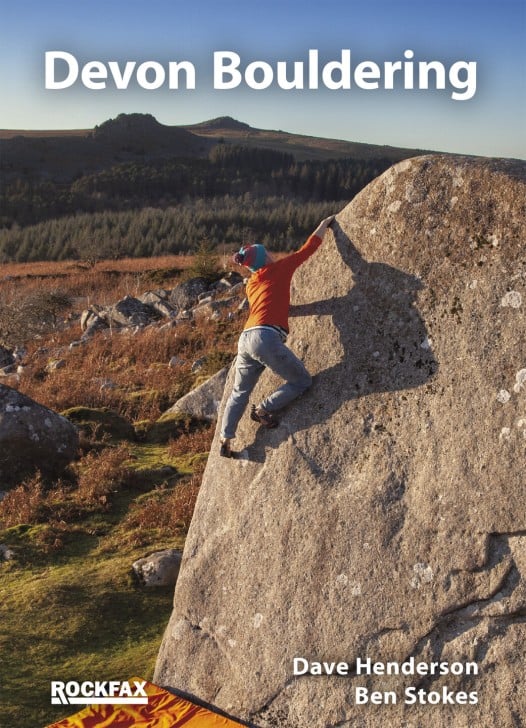
Devon Bouldering
Extensive coverage of bouldering of the moors, tors and woods of Devon. Produced in familiar Rockfax style with detailed photo topos, maps and overviews and lots of action photos. Also available on Rockfax Digital with extra areas.
More info

















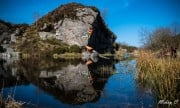

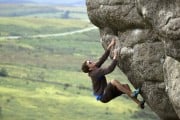
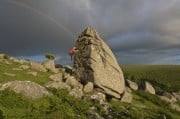
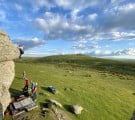
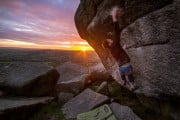
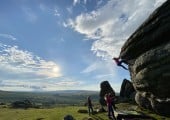



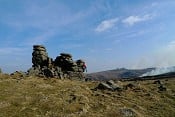
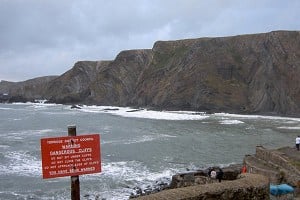
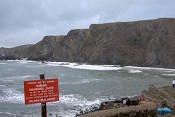
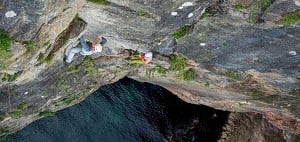




Comments
Excellent read, thanks!
I’ve got many fond memories of printing out pages for javu, back when I started climbing in the early 2000s. It was such a great resource, both for the topos and the articles.
Edit: I've just found the following photo of me paying homage to the brilliantly named Hound of the Basket Meals burger van in 2008
I've only had one day bouldering on Dartmoor back in 2006/07 and I can confirm that it is the possibly the roughest rock on earth. Maybe slightly less destructive than Hampi, though not by much!
There's an article in this isn't there - where is the world's sharpest rock?!
Dartmoor is a given, as is Hampi. Bishop is pretty bad, or good - depending on what you're into. Gabbro is rough, as opposed to sharp, so that's out. I'm sure there's some grim limestone venues that feature small/sharp crimps, but the fact that Dartmoor is literally coated with razorblades means that it trumps anything with an isolated sharp hold here or there...
Sicily deserves a mention for incredibly sharp limestone, totally shredded skin after a week there. But Dartmoor will destroy the skin of the unwary in hours/minutes.